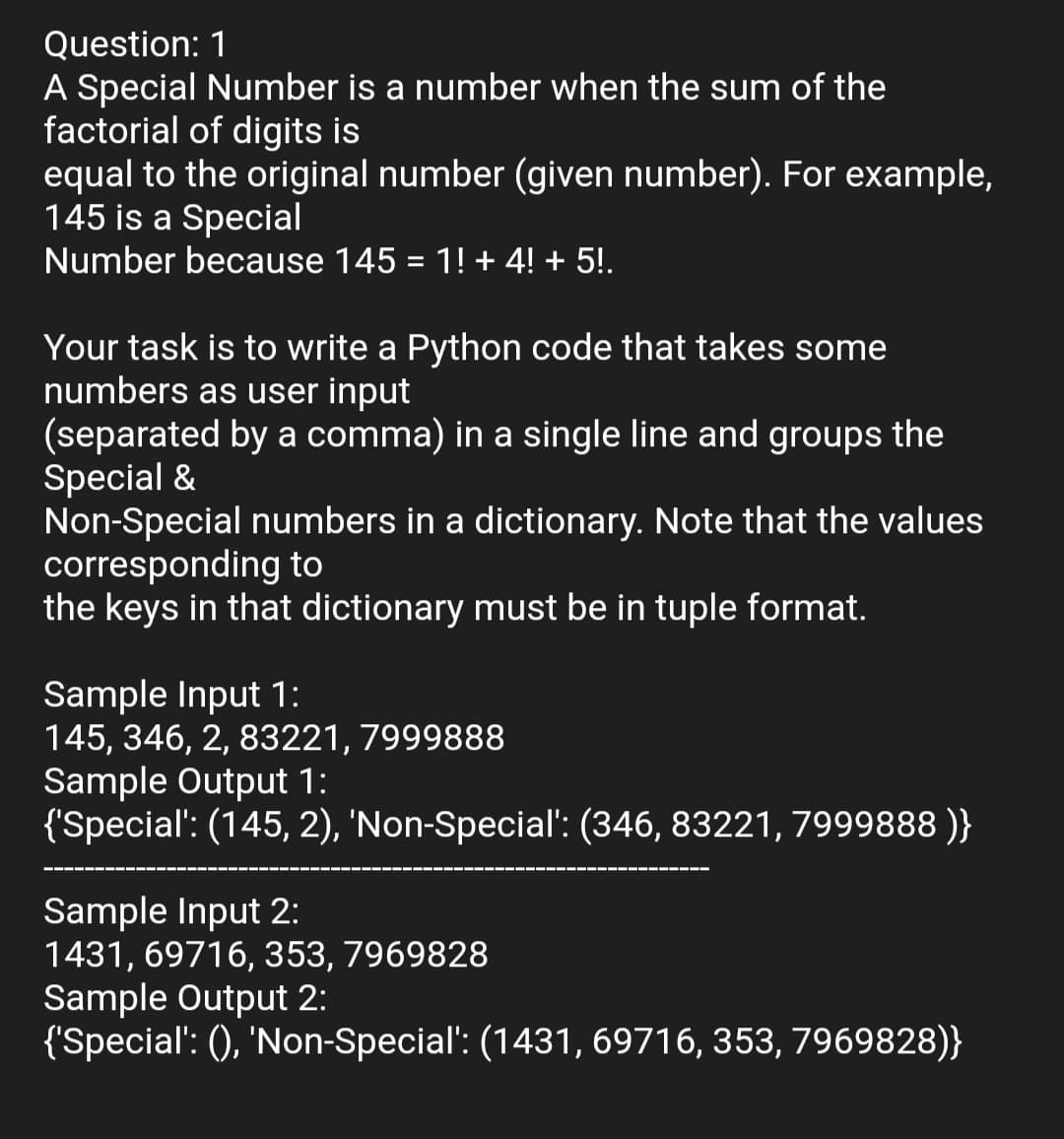Question: 1 A Special Number is a number when the sum of the factorial of digits is equal to the original number (given number). For example, 145 is a Special Number because 145 = 1! + 4! + 5!. Your task is to write a Python code that takes some numbers as user input (separated by a comma) in a single line and groups the Special & Non-Special numbers in a dictionary. Note that the values corresponding to the keys in that dictionary must be in tuple format. Sample Input 1: 145, 346, 2, 83221, 7999888 Sample Output 1: {'Special': (145, 2), 'Non-Special': (346, 83221, 7999888 )} Sample Input 2: 1431, 69716, 353, 7969828 Sample Output 2: {'Special': (), 'Non-Special': (1431, 69716, 353, 7969828)}
Question: 1 A Special Number is a number when the sum of the factorial of digits is equal to the original number (given number). For example, 145 is a Special Number because 145 = 1! + 4! + 5!. Your task is to write a Python code that takes some numbers as user input (separated by a comma) in a single line and groups the Special & Non-Special numbers in a dictionary. Note that the values corresponding to the keys in that dictionary must be in tuple format. Sample Input 1: 145, 346, 2, 83221, 7999888 Sample Output 1: {'Special': (145, 2), 'Non-Special': (346, 83221, 7999888 )} Sample Input 2: 1431, 69716, 353, 7969828 Sample Output 2: {'Special': (), 'Non-Special': (1431, 69716, 353, 7969828)}
Database System Concepts
7th Edition
ISBN:9780078022159
Author:Abraham Silberschatz Professor, Henry F. Korth, S. Sudarshan
Publisher:Abraham Silberschatz Professor, Henry F. Korth, S. Sudarshan
Chapter1: Introduction
Section: Chapter Questions
Problem 1PE
Related questions
Question
Please do it in python3 ASAP. THANK YOU

Transcribed Image Text:Question: 1
A Special Number is a number when the sum of the
factorial of digits is
equal to the original number (given number). For example,
145 is a Special
Number because 145 = 1! + 4! + 5!.
Your task is to write a Python code that takes some
numbers as user input
(separated by a comma) in a single line and groups the
Special &
Non-Special numbers in a dictionary. Note that the values
corresponding to
the keys in that dictionary must be in tuple format.
Sample Input 1:
145, 346, 2, 83221, 7999888
Sample Output 1:
{'Special': (145, 2), 'Non-Special: (346, 83221, 7999888 )}
Sample Input 2:
1431, 69716, 353, 7969828
Sample Output 2:
{'Special': (), 'Non-Special': (1431, 69716, 353, 7969828)}
Expert Solution
This question has been solved!
Explore an expertly crafted, step-by-step solution for a thorough understanding of key concepts.
Step by step
Solved in 4 steps with 3 images

Knowledge Booster
Learn more about
Need a deep-dive on the concept behind this application? Look no further. Learn more about this topic, computer-science and related others by exploring similar questions and additional content below.Recommended textbooks for you

Database System Concepts
Computer Science
ISBN:
9780078022159
Author:
Abraham Silberschatz Professor, Henry F. Korth, S. Sudarshan
Publisher:
McGraw-Hill Education

Starting Out with Python (4th Edition)
Computer Science
ISBN:
9780134444321
Author:
Tony Gaddis
Publisher:
PEARSON

Digital Fundamentals (11th Edition)
Computer Science
ISBN:
9780132737968
Author:
Thomas L. Floyd
Publisher:
PEARSON

Database System Concepts
Computer Science
ISBN:
9780078022159
Author:
Abraham Silberschatz Professor, Henry F. Korth, S. Sudarshan
Publisher:
McGraw-Hill Education

Starting Out with Python (4th Edition)
Computer Science
ISBN:
9780134444321
Author:
Tony Gaddis
Publisher:
PEARSON

Digital Fundamentals (11th Edition)
Computer Science
ISBN:
9780132737968
Author:
Thomas L. Floyd
Publisher:
PEARSON

C How to Program (8th Edition)
Computer Science
ISBN:
9780133976892
Author:
Paul J. Deitel, Harvey Deitel
Publisher:
PEARSON

Database Systems: Design, Implementation, & Manag…
Computer Science
ISBN:
9781337627900
Author:
Carlos Coronel, Steven Morris
Publisher:
Cengage Learning

Programmable Logic Controllers
Computer Science
ISBN:
9780073373843
Author:
Frank D. Petruzella
Publisher:
McGraw-Hill Education